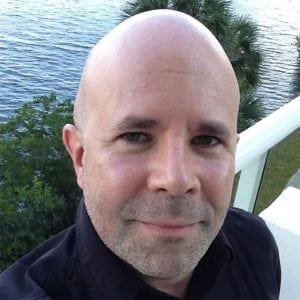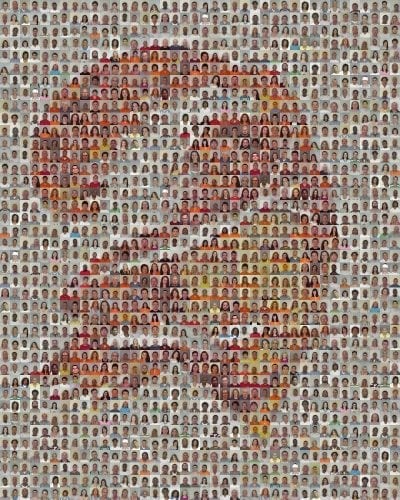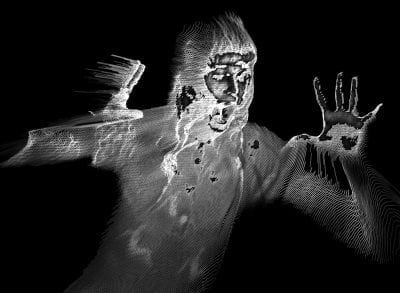
A Q&A With UT’s Digital Arts Guru Santiago Echeverry
by STEPHANIE POWERS | September 10, 2018
Digital artist Santiago Echeverry is a man of many hats. Many fabulous, inspiring, sophisticated and avant-garde hats. His art evolution and studies have led him from his home of Colombia to studying at NYU to the University of Tampa where he is an Associate Professor, Film, Animation and New Media. And Echeverry doesn’t just teach about art; he churns out his own work consistently. His most recent project Cabaret — videos and prints inspired by the LGBTQ nightlife characters — can be seen in large on YouTube or via his website. My favorite “Monday Night Scandals” represents the series perfectly. SHAMANS, which is the final piece in the series, will be shown Wednesday at the International Videoarts Festival at UT. Creative Pinellas spoke with Echeverry about the festival, why he left his South American hometown and, for the not-so-tech-smart readers, a little more info on what his art entails.
This month, we’re delving into animation arts in Creative Pinellas. What has been influential to you in the animation arts sphere lately?
Everything contains animation! Whether it’s in the credits, the visual effects, and even in basic scenes. Just like my wonderful colleague Doug Sutherland says: “If it’s got a dinosaur, it’s animation.”
The line between film and animation is getting blurrier and blurrier, and in a few years the same will be said about VR movies and traditional film. In my personal work, all of the videos created with the Kinect are actually processed as frame by frame animations, at 24 FPS. The capturing process produces individual image sequences that need to be processed and edited as traditional animations. The large format digital prints that I create are not still frames from a video, they are individual images that as a group create the illusion of movement.

For the non-tech types out there, would you please explain what it means to be a “New Media and Digital Artist”?
An artist is an artist no matter which format they choose. Digital artists start with screen-based supports to create their works, which can be displayed on a monitor or (can be) printed too. These can be time-based like video art or interactive animations and games. New Media artists may include screen-based works in their projects, but usually explore other issues such as spatiality, user-centered design, interactive reactions in their installations in order to expand the scope of the created piece. These pieces can be video projections, robotics, electronic performances and immersive mixed/virtual reality experiences.
How did this career come to fruition? Has this been an interest since you were young?
I was extremely lucky to have an older brother, Diego, that was a complete geek — in the early ’80s he already had a computer, and I remember him showing me the TI994A he had in his office (with a voice synthesizer). Because of him I started programming, spending countless hours transcribing code that came in European magazines, learning by copying, adapting and making mistakes until things worked. Even though I studied film and television in college, my passion for alternative methods of expression never went away, so I dove straight into Video art and Performance art.
What brought you to teach University of Tampa?
Most of the Colombians that came to the U.S. at the end of the ‘90s, left the country for security reasons, often leaving all of their possessions behind. My mom moved to Miami, for security reasons, in 1999. When I was finally able to come to the U.S. in 2003, I started teaching in Baltimore. I noticed that my mom needed me closer, and when I saw the job opening at the University of Tampa, I knew I had to come to Florida, just four hours away by car in case of an emergency. On an academic level, I chose UT because of my colleague Joanne Steinhard, one of the most brilliant women I have ever met, with whom I shared my passion for all things geek — we spoke the same language.

What classes do you teach at the University of Tampa?
I teach three core classes for Film, Animation and New Media majors and minors. The introductory level class, Digital Media, teaches the essential notions that we all use in our fields: basic programing, vector and pixel media, audio and animation. Creative Coding is a 300 level class that explores programming from a self expressive point of view. Students learn all the basic elements of programming in the context of multimedia, and produce a simple object- oriented programming video game as a final project. Online production is a web design class for geeks — it teaches you how to open the hood of the browser, and how to get your hands dirty in order to use the Web as a platform for creation, using CSS3, HTML5, JQuery on the client side and PHP one the server side.
Can you explain a little about the International Videoarts Festival?
Antenor Ferreira is the director of the Medialab — a computational art research laboratory in Brasilia, Brazil. He is also a percussionist and electroacoustic musician that also teaches in several universities in Europe and his native country. He personally invited 12 artists/musicians to produce new video art or visual music pieces to be premiered at the festival. This first edition seeks to explore the possibilities to produce such a large-scale event, and in future editions there will be an open call for works with a selecting group of jurors.
Are all 10 countries showing the same program?
All the international venues will present the same program, on the same date, Wednesday Sept. 12. Some of them will include the program as part of larger celebrations, like Uruguay, which is doing a videomapping show before the exhibition.

You have a piece SHAMANS in the Videoarts Festival. Can you tell us a about that?
I had the chance to spend a few weeks in London last year, and I got to meet four unique artists: Jonathan Armour is a digital media creator that is focusing on super large format body scans, as well as virtual reality. Angel Ito is a dancer, painter and performance artist originally from Puerto Rico, who has been living and creating in London for over 20 years. Stefan Djokic is an extremely talented young fashion designer, and Josh Quinton is a fashion icon, DJ and model that is just stunning. In the volumetric process they all performed naturally in front of the Kinect sensor, revealing their styles and personalities. In my interactions with them I realized that as artists we are shamans, creating not only our products but also each other as humans. This is what I try to capture in my short experimental piece. The music is composed and produced by Antenor Ferreira.
Is this festival similar to the Electronics Alive Festival? Will that happen again?
Electronics Alive died with Lew Harris’s retirement and my departure from the art department at UT. The new Film Animation and New Media Department (FMX) is currently organizing some exciting new projects, including the International Videoarts Festival, an upcoming animation festival and the newly revamped Florida Experimental Festival that found a new home at UT.
Where do you get your inspiration from?
My life has been quite difficult these past years. I need to find an escape from a repetitive reality, and for me teaching, creating and experimenting is the perfect refuge. Shamans can be considered as the last piece of my Cabaret Series, 19 videos and over 140 prints that study the lives of LGBTQ characters in the context of the tumultuous political situation of this country. My work and my research is my own personal #resistance.
Do you get back to Colombia often? What are the Digital Arts and New Media scenes there like?
I do not get back to my country as often as I would like to: ever since I became an American citizen, my priorities have shifted to exploring new horizons. But the beauty of my digital work is that it allows me to participate remotely in shows and lectures. Everything I do can be downloaded from my servers, and presented in multiple formats. That has kept my connection alive with my former students, colleagues and friends, and has allowed me to see that the seeds we planted in the ’90s are producing huge results, especially in the fields of experimental video, queer expressions, video mapping and education.
What does your future look like? What does the future of New Media look like?
I can only be certain that my future is totally and unforgivably uncertain. Fifteen years ago I was a teaching director. Ten years ago I was teaching Flash, and after Steve Jobs single-handedly killed it, I had to switch to HTML5/Javascript. People who were experts using one tool, become obsolete if they do not keep on learning and growing. Our field is definitely not like the traditional fine arts arena. We depend on technologies and tools that may be replaced by something new in the blink of an eye. I live in a permanent state of Post-Modern Crisis, and I LOVE IT: it keeps me alive!
The International Videoarts Festival will be held in the Reeves Theater of the Vaughn Center, University of Tampa, 6 to 8 p.m., Wed., Sept. 12, Free. For more information, go to videoartes.org.


